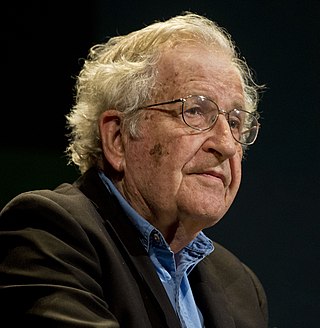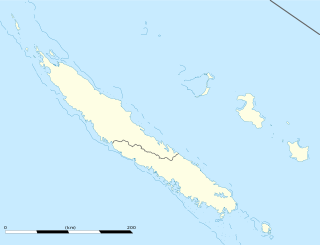A pidgin, or pidgin language, is a grammatically simplified means of communication that develops between two or more groups of people that do not have a language in common: typically, its vocabulary and grammar are limited and often drawn from several languages. It is most commonly employed in situations such as trade, or where both groups speak languages different from the language of the country in which they reside. Linguists do not typically consider pidgins as full or complete languages.

In linguistics, syntax is the study of how words and morphemes combine to form larger units such as phrases and sentences. Central concerns of syntax include word order, grammatical relations, hierarchical sentence structure (constituency), agreement, the nature of crosslinguistic variation, and the relationship between form and meaning (semantics). There are numerous approaches to syntax that differ in their central assumptions and goals.

Universal grammar (UG), in modern linguistics, is the theory of the innate biological component of the language faculty, usually credited to Noam Chomsky. The basic postulate of UG is that there are innate constraints on what the grammar of a possible human language could be. When linguistic stimuli are received in the course of language acquisition, children then adopt specific syntactic rules that conform to UG. The advocates of this theory emphasize and partially rely on the poverty of the stimulus (POS) argument and the existence of some universal properties of natural human languages. However, the latter has not been firmly established, as some linguists have argued languages are so diverse that such universality is rare, and the theory of universal grammar remains controversial among linguists.

A creole language, or simply creole, is a stable natural language that develops from the process of different languages simplifying and mixing into a new form, and then that form expanding and elaborating into a full-fledged language with native speakers, all within a fairly brief period of time. While the concept is similar to that of a mixed or hybrid language, creoles are often characterized by a tendency to systematize their inherited grammar. Like any language, creoles are characterized by a consistent system of grammar, possess large stable vocabularies, and are acquired by children as their native language. These three features distinguish a creole language from a pidgin. Creolistics, or creology, is the study of creole languages and, as such, is a subfield of linguistics. Someone who engages in this study is called a creolist.

Tok Pisin (, ; Tok Pisin
Linguistics is the scientific study of human language. Someone who engages in this study is called a linguist. See also the Outline of linguistics, the List of phonetics topics, the List of linguists, and the List of cognitive science topics. Articles related to linguistics include:
In grammar, a future tense is a verb form that generally marks the event described by the verb as not having happened yet, but expected to happen in the future. An example of a future tense form is the French aimera, meaning "will love", derived from the verb aimer ("love"). The "future" expressed by the future tense usually means the future relative to the moment of speaking, although in contexts where relative tense is used it may mean the future relative to some other point in time under consideration.
African-American Vernacular English (AAVE) is the variety of English natively spoken, particularly in urban communities, by most working- and middle-class African Americans and some Black Canadians.
Hawaiian Pidgin is an English-based creole language spoken in Hawaiʻi. An estimated 600,000 residents of Hawaiʻi speak Hawaiian Pidgin natively and 400,000 speak it as a second language. Although English and Hawaiian are the two official languages of the state of Hawaiʻi, Hawaiian Pidgin is spoken by many Hawaiian residents in everyday conversation and is often used in advertising targeted toward locals in Hawaiʻi. In the Hawaiian language, it is called ʻōlelo paʻi ʻai – "hard taro language". Hawaiian Pidgin was first recognized as a language by the U.S. Census Bureau in 2015. However, Hawaiian Pidgin is still thought of as lower status than the Hawaiian and English languages.

Derek Bickerton was an English-born linguist and professor at the University of Hawaii in Manoa. Based on his work in creole languages in Guyana and Hawaii, he has proposed that the features of creole languages provide powerful insights into the development of language both by individuals and as a feature of the human species. He is the originator and main proponent of the language bioprogram hypothesis according to which the similarity of creoles is due to their being formed from a prior pidgin by children who all share a universal human innate grammar capacity.
A mixed language is a language that arises among a bilingual group combining aspects of two or more languages but not clearly deriving primarily from any single language. It differs from a creole or pidgin language in that, whereas creoles/pidgins arise where speakers of many languages acquire a common language, a mixed language typically arises in a population that is fluent in both of the source languages.
In linguistics, relexification is a mechanism of language change by which one language changes much or all of its lexicon, including basic vocabulary, with the lexicon of another language, without drastically changing the relexified language's grammar. The term is principally used to describe pidgins, creoles, and mixed languages.
Unserdeutsch, or Rabaul Creole German, is a German-based creole language that originated in Papua New Guinea as a lingua franca. The substrate language is assumed to be Tok Pisin, while the majority of the lexicon is from German.

Belizean Creole is an English-based creole language spoken by the Belizean Creole people. It is closely related to Miskito Coastal Creole, San Andrés-Providencia Creole, and Jamaican Patois.
According to the theory of monogenesis in its most radical form, all pidgins and creole languages of the world can be ultimately traced back to one linguistic variety. This idea was first formulated by Hugo Schuchardt in the late 19th century and popularized in the late 1950s and early 1960s by Taylor (1961) and Thompson (1961). It assumes that some type of pidgin language, dubbed West African Pidgin Portuguese, based on Portuguese was spoken from the 15th to 18th centuries in the forts established by the Portuguese on the West African coast. This variety was the starting point of all the pidgin and creole languages. This would explain to some extent why Portuguese lexical items can be found in many creoles, but more importantly, it would account for the numerous grammatical similarities shared by such languages.

Tayo, also known as "patois de Saint-Louis", is a French-based Creole spoken in New Caledonia. It is spoken by about 3000 people in the village of Saint-Louis, about 15 km (9.3 mi) from the New Caledonian capital Nouméa. The language developed out of the contact of speakers of many different Kanak languages in the mission, and the use of French for official purposes and as the language of prestige. The language contains structural elements primarily from Melanesian languages and lexical elements mainly from French.
Nativization is the process through which in the virtual absence of native speakers, a language undergoes new phonological, morphological, syntactical, semantic and stylistic changes, and gains new native speakers. This happens necessarily when a second language used by adult parents becomes the native language of their children. Nativization has been of particular interest to linguists, and to creolists more specifically, where the second language concerned is a pidgin.
Tense–aspect–mood or tense–modality–aspect is a group of grammatical categories that are important to understanding spoken or written content, and which are marked in different ways by different languages.
Port Jackson Pidgin English or New South Wales Pidgin English is an English-based pidgin that originated in the region of Sydney and Newcastle in New South Wales in the early days of colonisation. Stockmen carried it west and north as they expanded across Australia. It subsequently died out in most of the country, but was creolised in the Northern Territory at the Roper River Mission (Ngukurr), where missionaries provided a safe place for Indigenous Australians from the surrounding areas to escape deprivation at the hands of European settlers. As the Indigenous Australians who came to seek refuge at Roper River came from different language backgrounds, there grew a need for a shared communication system to develop, and it was this that created the conditions for Port Jackson Pidgin English to become fleshed out into a full language, Kriol, based on English language and the eight different Australian language groups spoken by those at the mission.
Susanne Maria Michaelis is a specialist in creole linguistics who is affiliated with the Max Planck Institute for Evolutionary Anthropology in Leipzig. She was previously at Leipzig University and at the Max Planck Institute for the Science of Human History in Jena.






